
Zamia is a genus of cycad of the family Zamiaceae, native to North America from the United States throughout the West Indies, Central America, and South America as far south as Bolivia. The genus is considered to be the most ecologically and morphologically diverse of the cycads, and is estimated to have originated about 68.3 million years ago.

Clethra is a genus of flowering shrubs or small trees described as a genus by Linnaeus in 1753.
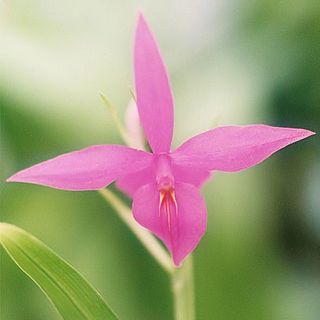
Barkeria, abbreviated Bark in horticultural trade, is a genus of orchids. It consists of about 17 currently recognized species native to Mexico and Central America. This genus was once considered part of Epidendrum. Type species is Barkeria elegans; this is now considered a synonym of B. uniflora yet retains its status as type per ICN.

Calyptrogyne is a genus in the palm family (Arecaceae). The distribution of this genus is Central America, Colombia, and southern Mexico, with 11 of the 17 known species endemic to Panama. Calyptrogyne ghiesbreghtiana is the most widespread and best studied species in this genus.

Dracontium is a genus of flowering plants similar to those of Amorphophallus. Unlike Amorphophallus which is found in the Old World, this genus has a New World distribution and is native to South America, Central America, southern Mexico, and the West Indies.

Greigia is a genus of plants in the family Bromeliaceae, subfamily Bromelioideae. It is native to Latin America from Mexico to Chile. The genus is named in honour of Major General Samuel Alexjewitsch Greig, president of the Russian Horticultural Society in 1865.
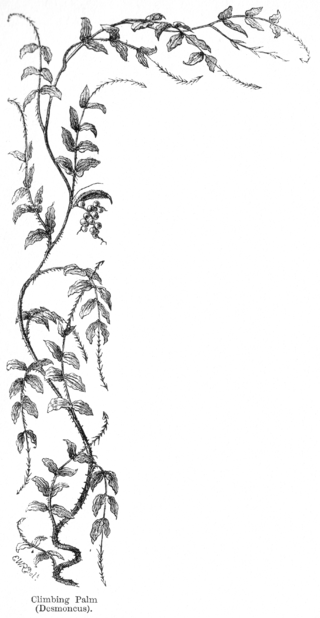
Desmoncus is a genus of mostly climbing, spiny palms native to the Neotropics. The genus extends from Mexico in the north to Brazil and Bolivia in the south, with two species present in the southeastern Caribbean.

Prestoea is a genus of palms native to the Caribbean, Central and South America. Its range extends from Nicaragua and the Greater Antilles in the north to Brazil and Bolivia in the south.

Cryosophila is a genus of medium-sized fan palms that range from central Mexico to northern Colombia. Species in the genus can be readily distinguished from related genera by their distinctive downward-pointing spines on the stem, which are actually modified roots. They are known as the "root spine palms".

Gonolobus is a genus of plant in family Apocynaceae, first described in 1803. It is native to South America, Central America, Mexico, the West Indies, and the southern United States.
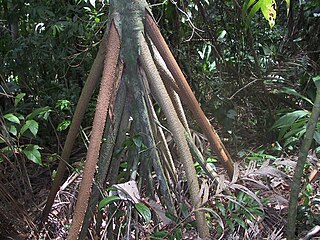
Socratea is a genus of five species of palms found in tropical Central America and South America.

Pholidostachys is a genus of palms found in Central America and northwestern South America.

Citharexylum is a genus of flowering plants in the verbena family, Verbenaceae. It contains shrub and tree species commonly known as fiddlewoods or zitherwoods. They are native to the Americas, ranging from southern Florida and Texas in the United States to Argentina. The highest diversity occurs in Mexico and the Andes. The generic name is derived from the Greek words κιθάρα (kithara), meaning "lyre", and ξύλον (xylon), meaning "wood," referring to the use of the wood in the sounding boards of string instruments. Several species, especially C. caudatum and C. spinosum, are cultivated as ornamentals.
- Citharexylum affineD.Don - from northern Mexico to Nicaragua
- Citharexylum alainiiMoldenke - Dominican Republic
- Citharexylum albicauleTurcz. - Cuba
- Citharexylum altamiranumGreenm. - northeastern Mexico
- Citharexylum andinumMoldenke - Bolivia, Jujuy Province of Argentina
- Citharexylum argutedentatumMoldenke - Peru
- Citharexylum berlandieriB.L. Rob. - from Texas to Oaxaca - Berlandier's fiddlewood, Tamaulipan fiddlewood
- Citharexylum bourgeauanumGreenm. - Veracruz, Oaxaca
- Citharexylum brachyanthum(A.Gray ex Hemsl.) A.Gray - Texas, Coahuila, Nuevo León - Boxthorn fiddlewood, Mexican fiddlewood
- Citharexylum bullatumMoldenke - Colombia
- Citharexylum calvumMoldenke - Quintana Roo
- Citharexylum caudatumL. - southern Mexico, West Indies, Central America, Colombia, Peru - Juniper berry
- Citharexylum chartaceumMoldenke - Peru, Ecuador
- Citharexylum cooperiStandl. - Costa Rica, Panama, Guatemala
- Citharexylum costaricenseMoldenke - Costa Rica, Nicaragua, Honduras
- Citharexylum crassifoliumGreenm - Chiapas, Belize, Guatemala, Honduras
- Citharexylum daniraeLeón de la Luz & F.Chiang - Revillagigedo Islands of Baja California
- Citharexylum decorumMoldenke - Colombia, Venezuela
- Citharexylum dentatumD.Don - Peru
- Citharexylum discolorTurcz. - Cuba, Hispaniola
- Citharexylum donnell-smithiiGreenm. - Oaxaca, Chiapas, Central America
- Citharexylum dryanderaeMoldenke - Colombia, Venezuela, Peru, Ecuador
- Citharexylum ekmaniiMoldenke - Cuba
- Citharexylum ellipticumMoc. & Sessé ex D.Don - Veracruz, Campeche, Tabasco; naturalized in Cuba + Cayman Islands
- Citharexylum endlichiiMoldenke - northeastern Mexico
- Citharexylum flabellifoliumS.Watson - Sonora, Baja California
- Citharexylum flexuosum(Ruiz & Pav.) D.Don - Bolivia, Peru
- Citharexylum fulgidumMoldenke - Veracruz, northeastern Mexico
- Citharexylum gentryiMoldenke - Ecuador
- Citharexylum glabrum(S.Watson) Greenm - Oaxaca
- Citharexylum glazioviiMoldenke - eastern Brazil
- Citharexylum grandiflorumAymard & Rueda - Ecuador
- Citharexylum guatemalense(Moldenke) D.N.Gibson - Guatemala, Nicaragua
- Citharexylum herreraeMansf. - Peru
- Citharexylum hexangulareGreenm. - from northern Mexico to Costa Rica
- Citharexylum hidalgenseMoldenke - Mexico
- Citharexylum hintoniiMoldenke - México State
- Citharexylum hirtellumStandl. - from Veracruz to Panama
- Citharexylum ilicifoliumKunth - Bolivia, Peru, Ecuador
- Citharexylum iltisiiMoldenke - Peru
- Citharexylum × jamaicenseMoldenke - Jamaica, Haiti, Puerto Rico (C. caudatum × C. spinosum)
- Citharexylum joergensenii(Lillo) Moldenke - Argentina, Bolivia
- Citharexylum karsteniiMoldenke - Colombia, Venezuela
- Citharexylum kerberiGreenm. - Veracruz
- Citharexylum kobuskianumMoldenke - Peru
- Citharexylum krukoviiMoldenke - eastern Brazil
- Citharexylum kunthianumMoldenke - Colombia, Venezuela, Ecuador
- Citharexylum laetumHiern - southern Brazil
- Citharexylum laurifoliumHayek - Bolivia, Peru
- Citharexylum lemsiiMoldenke - Guanacaste Province in Costa Rica
- Citharexylum × leonisMoldenke - Cuba (C. caudatum × C. tristachyum)
- Citharexylum ligustrifolium(Thur. ex Decne.) Van Houtte - Mexico
- Citharexylum lojenseMoldenke - Ecuador
- Citharexylum lucidumCham. & Schltdl. - Mexico
- Citharexylum lycioidesD.Don - Mexico
- Citharexylum macradeniumGreenm. - Panama, Costa Rica
- Citharexylum macrochlamysPittier - Panama, Colombia
- Citharexylum macrophyllumPoir. - Colombia, Venezuela, Ecuador, Guianas, northwestern Brazil
- Citharexylum matheanumBorhidi & Kereszty - Cuba
- Citharexylum matudaeMoldenke - Chiapas
- Citharexylum mexicanumMoldenke - Veracruz, Puebla, Oaxaca
- Citharexylum microphyllum(DC.) O.E.Schulz - Hisipaniola
- Citharexylum mirifoliumMoldenke - Colombia, Venezuela
- Citharexylum mocinoiD.Don - Mexico, Central America
- Citharexylum montanumMoldenke - Colombia, Ecuador
- Citharexylum montevidense(Spreng.) Moldenke - Brazil, Argentina, Paraguay, Uruguay
- Citharexylum myrianthumCham. - Brazil, Argentina, Paraguay
- Citharexylum obtusifoliumKuhlm - Espírito Santo
- Citharexylum oleinum Moldenke - Mexico
- Citharexylum ovatifoliumGreenm. - Mexico
- Citharexylum pachyphyllumMoldenke - Peru
- Citharexylum pernambucenseMoldenke - eastern Brazil
- Citharexylum poeppigiiWalp. - Colombia, Venezuela, Ecuador, Bolivia, Peru, Brazil
- Citharexylum punctatumGreenm. - Bolivia, Peru
- Citharexylum quercifoliumHayek - Peru
- Citharexylum quitenseSpreng. - Ecuador
- Citharexylum racemosumSessé & Moc. - Mexico
- Citharexylum reticulatumKunth - Ecuador, Peru
- Citharexylum rigidum(Briq.) Moldenke - Paraguay, southern Brazil
- Citharexylum rimbachiiMoldenke - Ecuador
- Citharexylum roseiGreenm. - Mexico
- Citharexylum roxanaeMoldenke - Baja California
- Citharexylum scabrumMoc. & Sessé ex D.Don - northern Mexico
- Citharexylum schottiiGreenm. - southern Mexico, Central America
- Citharexylum schulziiUrb. & Ekman - Hispaniola
- Citharexylum sessaeiD.Don - Mexico
- Citharexylum shreveiMoldenke - Sonora
- Citharexylum solanaceumCham. - southern Brazil
- Citharexylum spinosumL. – Spiny fiddlewood - West Indies, Panama, Venezuela, the Guianas; naturalized in India, Mozambique, Fiji, Bermuda
- Citharexylum stenophyllumUrb. & Ekman - Haiti
- Citharexylum steyermarkiiMoldenke - Veracruz, Chiapas, Guatemala
- Citharexylum suberosumLoes. ex Moldenke - Cuba
- Citharexylum subflavescensS.F.Blake - Colombia, Venezuela, Ecuador, Peru
- Citharexylum subthyrsoideumPittier - Colombia, Venezuela
- Citharexylum subtruncatumMoldenke - northwestern Brazil
- Citharexylum sulcatumMoldenke - Colombia
- Citharexylum svensoniiMoldenke - Ecuador
- Citharexylum teclenseStandl. - El Salvador
- Citharexylum ternatumMoldenke - Cuba
- Citharexylum tetramerumBrandegee - Valle de Tehuacán-Cuicatlán in Mexico
- Citharexylum tristachyumTurcz. – Threespike Fiddlewood - Cuba, Jamaica, Leeward Islands
- Citharexylum uleiMoldenke - Colombia, Peru, northwestern Brazil
- Citharexylum vallenseMoldenke - Colombia
- Citharexylum venezuelenseMoldenke - Venezuela
- Citharexylum weberbaueriHayek - Peru
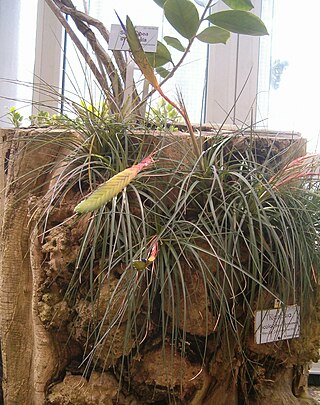
Tillandsia tricolor is a species of flowering plant in the genus Tillandsia. This species is native to Central America and Mexico.
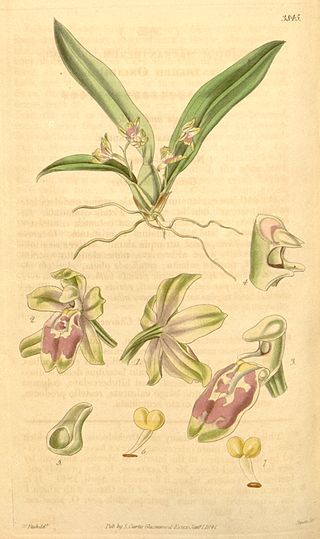
Leochilus is a genus of flowering plants from the orchid family, Orchidaceae, native to Mexico, Central America, northern South America, the West Indies and Florida.
- Leochilus carinatus(Knowles & Westc.) Lindl. - Oaxaca, Veracruz
- Leochilus crocodiliceps(Rchb.f.) Kraenzl. in H.G.A.Engler - Jalisco, Colima
- Leochilus hagsateriM.W.Chase - Oaxaca
- Leochilus inconspicuus(Kraenzl.) M.W.Chase & N.H.Williams - Costa Rica
- Leochilus johnstoniiAmes & Correll - from Oaxaca south to Nicaragua
- Leochilus labiatus(Sw.) Kuntze - from Oaxaca south to Brazil; also West Indies and Florida
- Leochilus leiboldiiRchb.f. - Oaxaca, Veracruz
- Leochilus leochilinus(Rchb.f.) M.W.Chase & N.H.Williams - Nicaragua, Costa Rica, Panama
- Leochilus oncidioidesKnowles & Westc. - Mexico, Guatemala, Honduras
- Leochilus puertoricensisM.W.Chase - Puerto Rico, St. Lucia
- Leochilus scriptus(Scheidw.) Rchb.f. - from southern Mexico south to Ecuador; also Cuba, Trinidad, Dominican Republic
- Leochilus tricuspidatus(Rchb.f.) Kraenzl. in H.G.A.Engler - Costa Rica, Panama

Rossioglossum is a genus of flowering plants from the orchid family, Orchidaceae. It has 9 currently recognized species, all native to Mexico, Central America, and northern and western South America.
- Rossioglossum ampliatum(Lindl.) M.W.Chase & N.H.Williams - from Guatemala to Venezuela and Peru
- Rossioglossum grande(Lindl.) Garay & G.C.Kenn. - Chiapas, Guatemala, El Salvador, Costa Rica
- Rossioglossum hagsaterianumSoto Arenas - Nayarit, Jalisco
- Rossioglossum insleayi(Baker ex Lindl.) Garay & G.C.Kenn. - from Jalisco to Oaxaca
- Rossioglossum krameri(Rchb.f.) M.W.Chase & N.H.Williams - Nicaragua, Costa Rica, Panama
- Rossioglossum oerstedii(Rchb.f.) M.W.Chase & N.H.Williams - Costa Rica, Panama
- Rossioglossum schlieperianum(Rchb.f.) Garay & G.C.Kenn. - Guatemala, El Salvador, Costa Rica, Panama
- Rossioglossum splendens(Rchb.f.) Garay & G.C.Kenn. - Oaxaca
- Rossioglossum williamsianum(Rchb.f.) Garay & G.C.Kenn - Chiapas, Guatemala, Honduras

Sarcoglottis is a genus of flowering plants from the orchid family, Orchidaceae. It is widespread across much of Latin America from Mexico to Argentina, with one species extending northward into Trinidad and the Windward Islands.

Cosmibuena is a genus of flowering plants in the family Rubiaceae. The genus is native to Chiapas, Central America, and South America as far south as Brazil.
Stenotyla is a genus of orchids. It contains 9 known species, all native to Central America and southern Mexico.
- Stenotyla estrellensis(Ames) P.A.Harding - Costa Rica
- Stenotyla francoiArchila - Guatemala
- Stenotyla helleri(Fowlie) P.A.Harding - Nicaragua
- Stenotyla lankesteriana(Pupulin) Dressler - Costa Rica, Panama
- Stenotyla lendyana(Rchb.f.) Dressler - Oaxaca, Chiapas, Guatemala, El Salvador, Honduras
- Stenotyla maculataArchila - Guatemala
- Stenotyla maxillapertaArchila - Guatemala
- Stenotyla panamensisPupulin - Panama
- Stenotyla picta(Rchb.f.) Dressler - Costa Rica, Panama



















